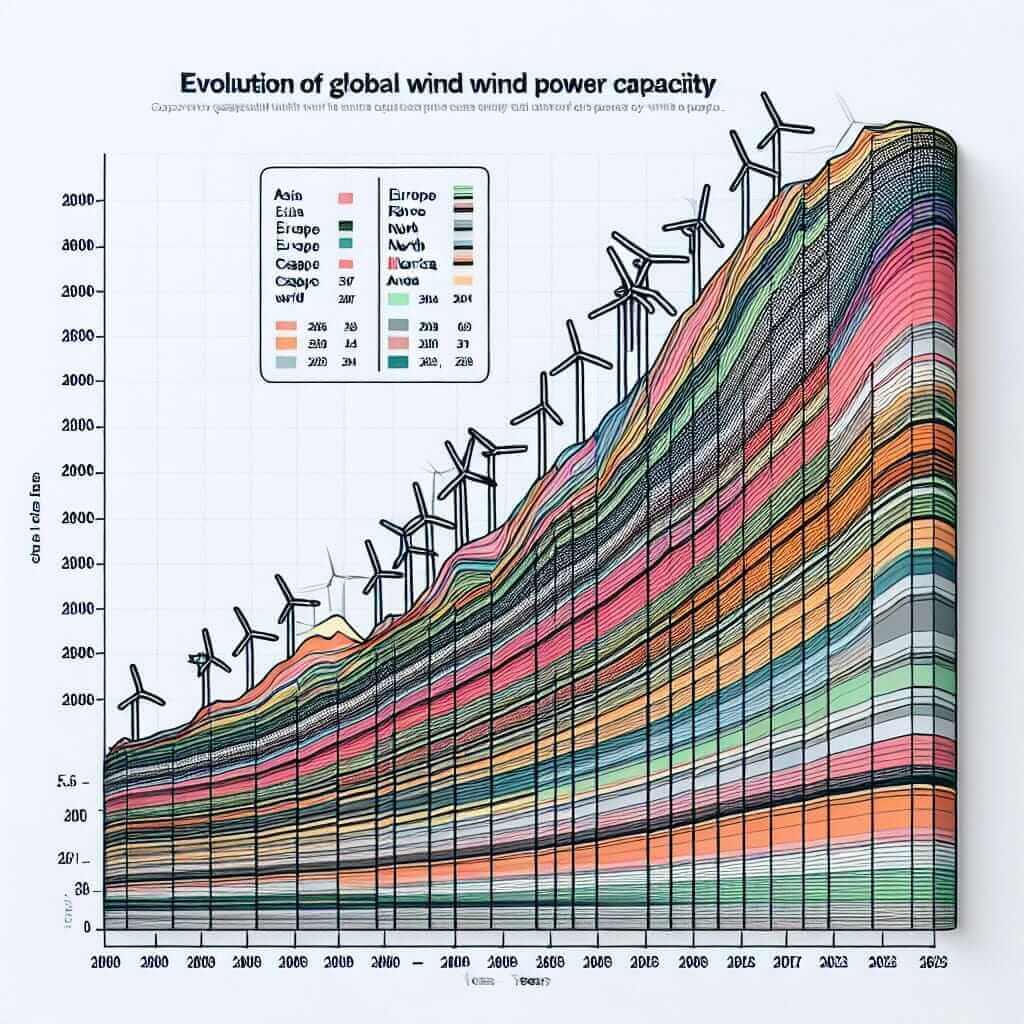The IELTS Writing Task 1 often presents data in various forms, and one common type is a line graph. Understanding how to effectively describe trends, compare data points, and use appropriate vocabulary is crucial for achieving a high band score. This article focuses on “Wind Power Capacity by Region (2000-2023)” – a topic that frequently appears in the IELTS exam. We’ll analyze real test data, provide a sample answer, and offer valuable tips to help you excel in your IELTS Writing Task 1.
Understanding the Trend: Wind Power Capacity
Before delving into the specifics, let’s break down the core concept:
- Wind Power Capacity: This refers to the maximum amount of electricity that can be generated from wind energy sources in a particular region at a specific time. It’s typically measured in megawatts (MW) or gigawatts (GW).
- By Region: This indicates that the data will be categorized and presented based on geographical areas (e.g., continents, countries).
- (2000-2023): The data spans over a period, showing the historical growth and potential future trends in wind power capacity.
Sample IELTS Writing Task 1 Question
You should spend about 20 minutes on this task.
The line graph below shows the global wind power capacity from 2000 to 2023, divided by regions.
Summarise the information by selecting and reporting the main features and make comparisons where relevant.
(Insert line graph here – Source: Reliable renewable energy statistics website)

Data Analysis
The provided line graph illustrates a clear upward trend in global wind power capacity from 2000 to 2023. While all regions experienced growth, Asia and Europe emerged as dominant players. Asia’s wind power capacity surged dramatically, surpassing Europe in the late 2000s and maintaining a significant lead thereafter. North America, initially a leader, showed steady but less pronounced growth compared to Asia. Other regions, while starting later, demonstrated a gradual increase in wind power adoption.
Sample Answer
The line graph provides a comprehensive overview of global wind power capacity trends from 2000 to 2023, segmented by region. Overall, a consistent upward trajectory is observed, signifying the growing adoption of wind energy worldwide.
At the beginning of the millennium, North America led the way with the highest wind power capacity, followed by Europe. However, Asia witnessed an explosive growth, overtaking both regions in the late 2000s. This remarkable surge positioned Asia as the dominant region in wind power capacity, a position it maintained until 2023.
Europe also exhibited a steady increase in wind power capacity throughout the period, albeit at a more moderate pace compared to Asia. In contrast, North America, while experiencing growth, fell behind the other two leading regions.
Other regions, including South America, Africa, and Oceania, demonstrated a more gradual adoption of wind power. Despite starting later, their wind power capacity exhibited a consistent upward trend towards 2023.
In conclusion, the graph clearly depicts the global shift towards renewable energy sources, with wind power capacity significantly increasing across all regions. Asia’s remarkable growth highlights its leading role in this energy transition. (Word count: 190 words)
Key Takeaways
- Structure: Follow a clear structure: Introduction, Overview (summarizing the main trend), Body Paragraphs (describing specific details and comparisons), Conclusion (re-stating the main trend).
- Vocabulary: Use a range of vocabulary to describe trends (increase, surge, decline, fluctuate), speed (rapidly, steadily, gradually), and make comparisons (higher than, lower than, in contrast to).
- Grammar: Pay attention to tenses (past simple for past data, present perfect for trends continuing to the present), subject-verb agreement, and accurate use of prepositions.
Essential Vocabulary
- Capacity (n): /kəˈpæsɪti/ – the maximum amount that something can contain or produce.
- Surge (v): /sɜːrdʒ/ – to increase suddenly and powerfully.
- Dominant (adj): /ˈdɒmɪnənt/ – more important, powerful, or noticeable than other things.
- Gradual (adj): /ˈɡrædʒuəl/ – happening or changing slowly over a long period of time.
- Trajectory (n): /trəˈdʒektəri/ – the curved path that an object follows after it has been thrown or shot into the air.
Conclusion
Mastering the IELTS Writing Task 1 requires practice and a good understanding of data interpretation and language skills. By analyzing sample questions, understanding key vocabulary, and following the tips outlined above, you can significantly improve your ability to achieve your desired band score. Remember to focus on clarity, accuracy, and a well-structured response.